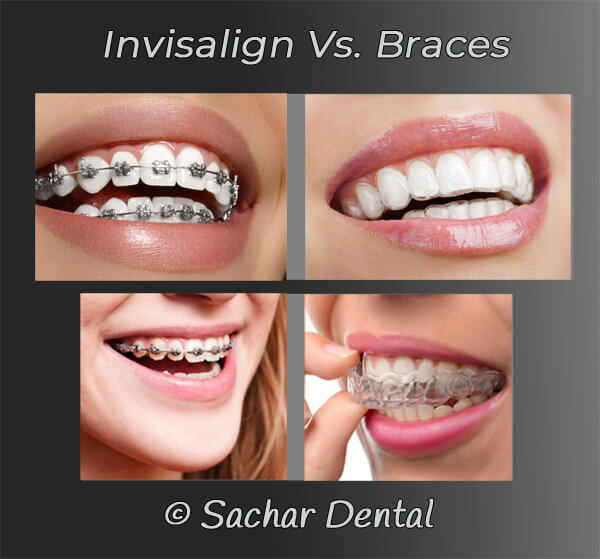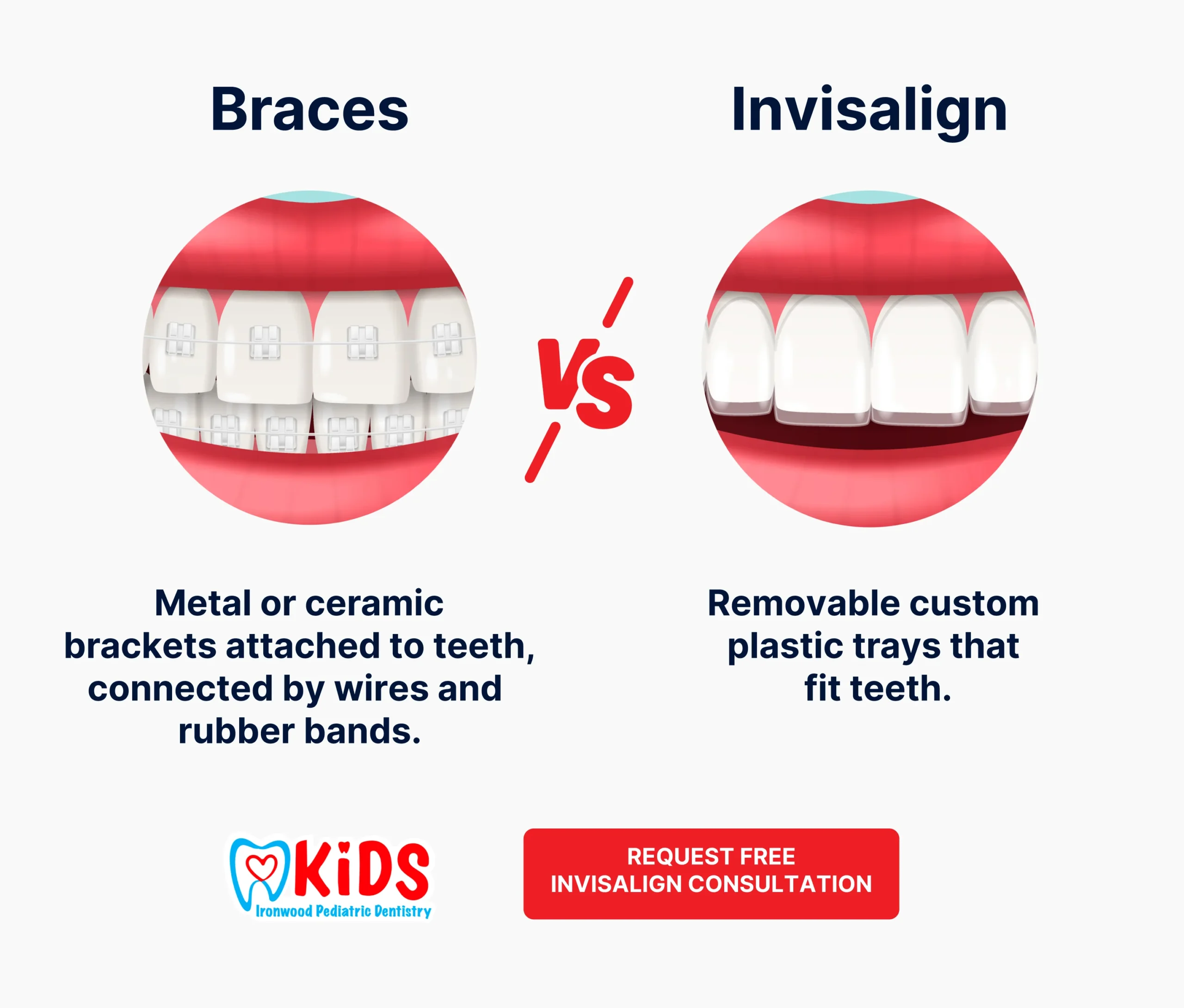Invisalign vs. Traditional Braces: Which Alternative Is Right for You?
When thinking about orthodontic therapy, the option in between Invisalign and typical dental braces provides several vital aspects that merit cautious evaluation. Invisalign provides a discreet alternative with detachable aligners, while conventional dental braces offer a much more noticeable yet effective service for severe misalignment.
Overview of Therapy Alternatives

On the other hand, typical braces consist of steel brackets and wires that are bound to the teeth. This technique uses constant stress over time to attain placement. While reliable for complex orthodontic concerns, conventional dental braces need regular sees for modifications and can posture challenges in preserving oral hygiene due to the problem of cleaning about brackets and cables.
Both choices have their qualities, and the choice often depends upon specific oral problems, way of living choices, and patient conformity. Inevitably, speaking with an orthodontic specialist is critical for identifying one of the most suitable treatment strategy tailored to private requirements. Recognizing the nuances of each choice can considerably affect the overall success of orthodontic treatment.
Visual Factors To Consider
A significant factor affecting the option in between Invisalign and standard braces is the visual charm each treatment supplies. Invisalign aligners are crafted from clear plastic, making them practically undetectable when worn. This very discreet look is especially interesting adults and teens who might feel awkward concerning their orthodontic treatment. The capacity to preserve an all-natural smile throughout the alignment process can considerably boost the person's confidence in social and professional settings.
In contrast, conventional dental braces contain metal braces and cables, which can be a lot more visible. While improvements in orthodontic innovation have actually resulted in the advancement of smaller sized braces and tinted elastics, traditional dental braces still keep a more noticeable profile. For some individuals, the visibility of dental braces may discourage them from seeking needed treatment.
Ultimately, the selection in between Invisalign and traditional braces may depend upon personal choices relating to looks. Individuals that focus on discernment frequently lean towards Invisalign, while those that are less concerned about presence might decide for conventional braces. Understanding the visual implications of each option is vital for making an educated choice that lines up with one's way of life and preferences.
Comfort and Convenience

In terms of benefit, Invisalign aligners are detachable, allowing patients to appreciate their preferred foods without constraint and keep optimal dental health. Cleaning and flossing are simplified, as the aligners can be obtained throughout these routines, whereas traditional braces require cautious steering around cables and braces.
In comparison, standard dental braces necessitate regular modifications, making them less convenient for those with active routines. In general, the comfort and benefit of Invisalign make it an enticing option for several individuals looking for orthodontic therapy.
Therapy Period and Effectiveness
While both Invisalign and conventional braces work in remedying oral misalignments, the duration of treatment can differ dramatically in between the two options. Commonly, Invisalign therapy can take anywhere from 12 to 18 months, depending upon the complexity of the instance. The clear aligners work by progressively shifting teeth right into their preferred settings, and normal follow-ups with an orthodontist assistance guarantee development continues to be on track.
In comparison, conventional dental braces typically need a longer dedication, generally ranging from 18 months to 3 years. This results from their set nature and making use of cables and braces, which can be more effective for serious misalignments and complex cases (Invisalign). The treatment effectiveness of typical dental braces is well-documented, as they enable for specific changes and better control over tooth motion
Eventually, the selection between Invisalign and traditional dental braces may depend upon both the awaited therapy period and the details dental concerns handy. Consulting with an orthodontist is crucial, as they can provide tailored suggestions based on individual requirements, ensuring the picked approach lines up with wanted results and durations.
Expense Contrast and Insurance Choices
Price plays a considerable function in the decision-making procedure for individuals considering orthodontic therapy, whether selecting Invisalign or typical dental braces. Typically, the expense of Invisalign arrays from $3,000 to $8,000, while typical dental braces normally cost in between $2,000 and $6,000. Elements influencing these expenses consist of the intricacy of the case, the duration of therapy, and geographical place.
Insurance insurance coverage can dramatically affect out-of-pocket expenditures. Lots of oral insurance plans supply partial insurance coverage for orthodontic therapies, but the specifics can differ extensively. It is important for individuals to review their insurance plan to identify the extent of coverage for either option. Generally, standard dental braces might be extra frequently covered by insurance coverage strategies contrasted to Invisalign, my sources which some insurance firms categorize as a cosmetic treatment.
Additionally, numerous orthodontic practices use versatile settlement strategies, making both treatment options much more easily accessible. Individuals must make inquiries concerning potential funding alternatives and discounts for upfront payments. Examining the overall expense, including insurance advantages and layaway plan, is vital for making an informed choice that straightens with both visual preferences and budget plan factors to consider.

Final Thought
In recap, the choice in between Invisalign and typical braces depends upon multiple factors, including visual preferences, comfort, therapy duration, and expense. Invisalign supplies a discreet, detachable alternative that assists in dental health and dietary flexibility, while typical dental braces may be preferable for complicated oral issues and frequently come at a lower More Help cost factor. Eventually, appointment with an orthodontist is vital to analyze individual scenarios and figure out the most proper treatment option for attaining optimum dental alignment.
When taking into consideration orthodontic therapy, the option in between Invisalign and standard braces provides a number of visit the website crucial factors that merit careful examination.Contrasting Invisalign and typical braces discloses unique treatment options for orthodontic improvement.While both Invisalign and typical dental braces are efficient in fixing oral misalignments, the duration of therapy can vary substantially in between the two choices.Expense plays a substantial duty in the decision-making process for individuals taking into consideration orthodontic treatment, whether choosing for Invisalign or typical braces.In recap, the choice in between Invisalign and conventional dental braces pivots on multiple variables, including visual choices, convenience, therapy period, and cost.